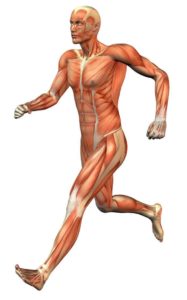Anatomy and physiology
If we’re going to design for people, we need to know how the human body works, both in terms of physical characteristics and cognitive abilities, and what aspects of design will have a direct impact on the people involved.
How does the human body work?
 The musculoskeletal system is the framework for the body made up of the bones of the skeleton, the muscles and the tendons which attach the muscles to the bones. Movement is enabled by the joints which may be simple hinge joints like the elbow or more complex ball and socket joints like the shoulder. Ligaments hold the separate bones of the joints together whilst still allowing a useful range of movement.
The musculoskeletal system is the framework for the body made up of the bones of the skeleton, the muscles and the tendons which attach the muscles to the bones. Movement is enabled by the joints which may be simple hinge joints like the elbow or more complex ball and socket joints like the shoulder. Ligaments hold the separate bones of the joints together whilst still allowing a useful range of movement.
Physiology is the study of the functions and mechanisms which work within us. Our metabolism describes the chemical reactions within the body that are used to produce energy, allowing us to function and move. Control of movement is brought about by our nervous system with feedback being provided by our senses.
Physical ability is primarily affected by strength, work capacity, endurance and fatigue:
- Strength primarily depends on gender, age (strength generally decreases as you get older) and training for the task.
- Work capacity is often measured through the level of oxygen uptake to the working muscles, and through heart rate which shows how quickly oxygen can get around the body.
- Endurance can be increased in several ways including by eliminating unnecessary movement, using body weight together with momentum and gravity, and allowing a variety of movements and postures.
- Fatigue can be reduced by minimising static work (holding a position), working with the joints in the mid-range of movement, keeping forces low and ensuring sufficient breaks.
